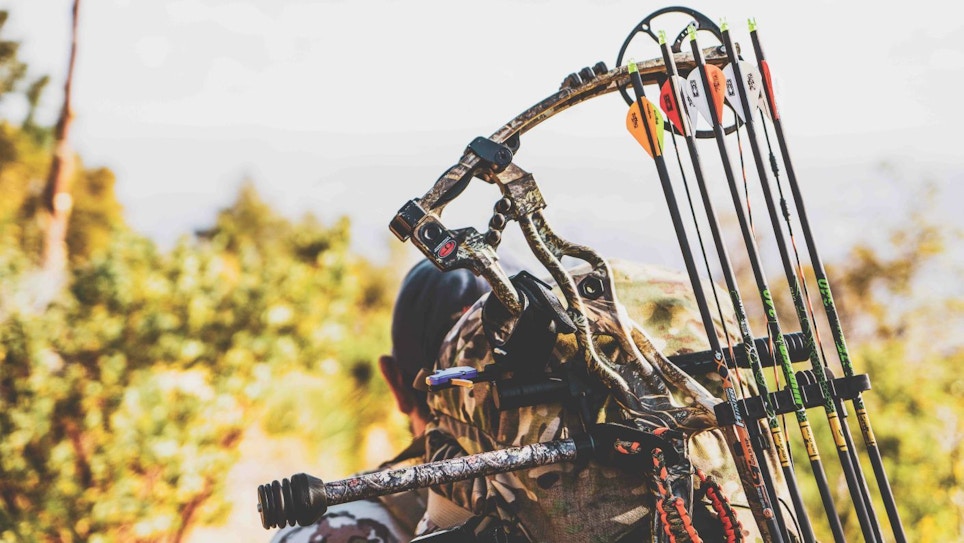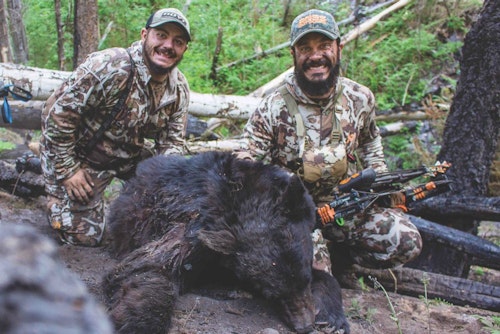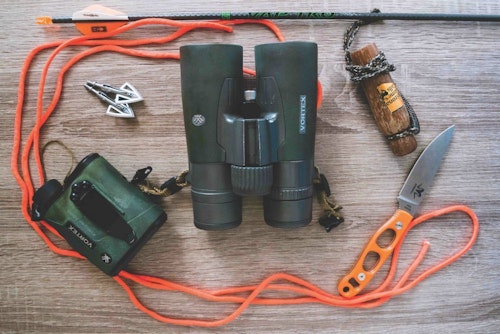Hunters across the nation are brushing up on their turkey calling and making sure their decoys are ready to go. For me, though, I only have one thing on my mind — black bears.
The spring black bear season takes up quite a bit of my time in March. Across the United States, black bear hunting is commonly associated with baiting. While I don’t have any problem with that at all, baiting is not a legal hunting method in my home state of Arizona. For a guy who likes bowhunting, this poses a challenge and forces one to find other avenues for success.
One that I have truly come to love is spot-and-stalk black bear hunting with my bow. The feeling of sneaking into bow range of a large bruin is unmatched in my book, and one that is definitely worth the effort. Here are some things I’ve learned through my years of pursuing black bears.
Finding Spring Black Bears
In order to successfully spot-and-stalk black bears with your bow, the first thing you’ve got to do is be able to find them consistently. This can be quite tricky because bears are relatively reclusive animals. I often refer to bears as “shadow walkers” because of this. In my experience, bears like steep, deep, water-filled canyons. Canyon bottoms, especially those that hold water year-round, are like roadways for bear travel.
Additionally, all sorts of bear food grows on the surrounding hillsides. Bear country is rugged, which keeps most folks out. So, if you want a bear, be prepared to work for it because the terrain isn’t for the faint of heart. While bears traverse through it effortlessly, don’t let them fool you; it’s their backyard.
Elevation
Another attribute of bear country to pay attention to is elevation. In my mind, the relationship between elevation and food is critical when it comes to finding bears consistently. We’ll get into food later, but elevation plays a huge role in regard to which food is ripe and when.
Den locations are also connected with elevation. The deeper into the season, the farther from the dens the bears are willing to travel. In the early season, bears can oftentimes be found at lower elevations, because that is where the food will ripen up first. As the snow melts, they’ll make their way back into higher elevations.
Of course, there are exceptions to the rule depending on where a bear decides to den. I believe that bears den at a wide variety of elevations, causing them to leave dens at various times in the spring.
Optics Are Key
The absolute best way I have found to find bears is by sitting down with my binocular and scanning the countryside. Mounting your optic on a tripod goes a long way, too. By doing so, a hunter is cutting out the natural shake that comes from free-handing their optic.
During spring, bears can be observed all day in my experience. They are homed-in to their weight-gaining needs and can be found on food sources from sunup to sundown. This provides the opportunity to observe bears from afar and make a game plan for a stalk. Of course, if you aren’t looking in the right area, you aren’t likely to see them, which brings me to my next point: finding the right food sources.
The Bear Necessities
A common phrase that an eager-to-learn bear hunter might hear is “If you find the food, you’ll find bears.” There is a lot of truth in those few words. It is a pretty broad statement though, if you ask me. It should be stated as “When you find the right food, you’ll definitely find bears.”
During spring, most bears are going to be heavily concentrated on bright-green grass. Large south-facing slopes are great locations to find green grass because they get the most sunlight, which snow melts from first, allowing the green-up. Later in the season, bears may concentrate on north-facing hillsides. They’ll continue to eat grass, but will also move onto other foods such as berries, leaves, flowers, and then fawns and calves later in the summer.
Finding food sources and boot leather go hand-in-hand — or is it foot-on-foot? It’s essential for a bear hunter to search out food sources. The reason being is they can change from year to year depending on elements such as annual precipitation. Some years, there might not be a good spring berry crop. Other years it might be acorns or juniper berries. Ensure you are focused on the right crop in the right location. Follow the food, because that’s what the bears do.
Closing the Distance
Now, we’re getting into the meat and potatoes; the fun part. Once you’ve glassed a hungry spring black bear meandering its way along a hillside, it’s time to close the distance. The more black bears a hunter watches, the more they will get an idea of how they move around, which is completely random.
Some situations are better than others. For instance, if you observe a bear traveling, depending on the distance, this might not be a good bear to go after. They just move too fast and the likelihood of them being there when you arrive is slim. A bear feeding, though, is a bear that can be pursued. Because of how keyed-in bears get on their food, you can rest-assured this bear isn’t going anywhere fast.
I’ve observed bears for up to four hours on the same hill. As a bowhunter, you need time to close the distance, and a feeding bear gives you just that. It also skews their attention from their surroundings. If they are gone by the time a hunter arrives, a great tactic is to just post up in the area. Bears will head off to sleep for a bit and then come right back out into the same feeding area they were in earlier. A bear coming to you is easier than you going to the bear.
The good thing about stalking bears is their eyesight is good but not great. One should be able to sneak in with relative ease without being seen. That is, if you can get past their keen smelling and hearing. A bear’s nose is uncanny in the animal kingdom. They have a sense of smell seven times better than that of a bloodhound. A bloodhound’s is 300 times greater than a human. In light of that, not having the wind in your favor on your approach, is simply not acceptable. A hunter can make some noise, but a bear will not tolerate smelling them. Monitor the wind closely throughout a stalk for any hope of success.
Stalking Tips
During the stalk, I like to be aggressive until I get within a certain range of the bear. If I see a bear that is 700 yards away, you can bet I’m going to bust my butt and move as quickly as I can to get to the 100-yard mark. The reason is bears are like pinballs on a hill. The faster you can close the distance, the better chance you have of the bear still being there upon your arrival.
Once the distance has been closed, slow down and mind every footfall. Pick a general route beforehand and stick to it, if you can. Things can change quickly with the bears though, so be ready to pick a new route on the fly after you’ve closed the distance.
Now, say you’ve glassed a bear, made your approach and are within bow range. The stalk is looking good but it’s not over yet. An arrow still needs to be sent. Getting a shot on a black bear can be easy and difficult at the same time. Easy, because if they are right in the middle of feeding, they’re not moving much. Difficult, because it always seems bears are more often than not, moving.
This can pose a challenge when trying to get a shot off. Of course, a hunter can try to make a noise to stop the bear. I like shooting at an animal that has no idea I’m there, though. Accomplishing that is all about patience and waiting for the right shot angle. Wait for a broadside or quartering-away shot, and aim a tad farther back than you’d shoot a deer. A famous line that describes this is “middle of the middle.” In my opinion, this will ensure a quick death.
Predator Calling
Another way to close the distance on a spring black bear is to bring them to you. It sounds crazy, I know, but using a predator call for bears works well. It works especially well during the fawn and calf drop. These are easy meals, so when a bear hears a distress noise, they are likely to come take a closer look.
Another good call is a cub in distress, as big boars often will kill cubs for food or biological reasons. When calling, spend approximately 45 minutes at each stand. Bears get distracted easily, so it pays to call longer.
Gobble Up Bear Hunting
So, you see, spring isn’t just about gobbles. There is plenty of opportunity out there for a hunter to try their luck at sneaking into bow range of a black bear. With any luck, they’ll be bringing home some of the most underrated meat available, along with a beautiful bear hide.
In addition, you’ll have a heck of a story to tell. Bowhunting bears is always an adventure. Maybe that’s why I’ve been so drawn to it. From the breathtaking country they live in to the jaw-dropping close encounters, black bears have my heart. Having those close encounters with a bow in your hand takes things to the next level.
Don’t believe me? Try it for yourself.
Sidebar: Spot-and-Stalk Black Bear Gear
An essential few pieces of gear when spot-and-stalk bear hunting are my optics, predator call and fixed-blade knife. For me, a binocular and spotting scope are an absolute must for bear hunting. In my opinion, there is no better way to hunt than sitting on a high vantage point and scanning the country for bears. For this I prefer the Vortex 10x42 Razors paired with a Vortex 11x33x55 spotting scope. Another important optic is my rangefinder. Getting a solid range on a bear is critical. I use a Vortex Ranger 1000. It’s compact and easy to use.
Aside from my optics, I will never go into the field on a bear hunt without a predator call — even if I’m not planning on calling. The reason is if a bear disappears into an area that might be too thick for me to sneak through, I can potentially lure it back out with a call. This has worked several times in the past for me.
Lastly, bear bones are pretty thick. It pays to have a good fixed-blade knife to really get into those tough joints. The Argali Carbon Knife is my choice for this. It’s lightweight and tough.










